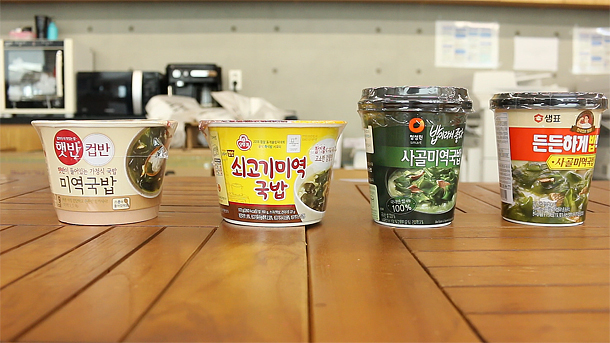Instant rice cups offer tasty snack

Four ready-made miyeokguk (seaweed soup) cup rice products from CJ CheilJedang, Ottogi, Chungjungone and Sempio. The products serve a warm cup of soup in just three to five minutes. [LEE JA-EUN]
The most attractive thing about these cup rice products is that everything’s set up for you; all you have to do is pour hot water into the cup and microwave it for three to five minutes. They even come with disposable spoons inside, so you don’t even have to wash anything afterwards. On top of the convenient packaging, the rice fills you up and does not give you the momentary and guilty sensation that comes after eating instant noodles.
Chungjungone was the first to enter the cup rice market in March 2013, when it released four types of ready-made rice and soup inside portable cups. Within just two months of release, the company sold more than 300,000 cups across the country. After the company surveyed customers on what they would like to see, Chungjungone created the miyeokguk cup rice in December of the same year. CJ CheilJedang and Ottogi followed in 2015, and Sempio released their first cup rice product this year.
The cheapest is Ottogi’s product which costs 3,000 won ($2.62) and the most expensive is CJ’s, which costs 3,500 won.
For most Korean soups, the flavor, and thus the quality of the soup, depends mostly on the ingredients. While all four products chose beef leg bones and beef meat as a base for the broth, Sempio differentiated itself by using only top quality Korean beef and CJ used dried pollack to add a richer note. Ottogi and CJ used ready-cooked rice, whereas Chungjungone and Sempio chose dried rice. Although dried rice felt less chewy, the lightness of the cup makes it easier to carry around.
The sodium levels of cup rice are half those of instant noodles of a similar volume. A common cup noodle has 450 to 500 calories, but the cup rice products’ calories were only around 250 calories. Although Sempio’s numbers were the lowest with 245 calories, Chungjungone and Ottogi were more or less the same with 260 and 270 calories. On the contrary, the products’ sodium levels varied, with Sempio having 790 milligrams, CJ having 960 milligrams, Chungjungone having 1,020 milligrams and Ottogi having 1,040 milligrams.
Five staff members from the JoongAng Ilbo took part in a blind test, in which Chungjungone and Ottogi scored the highest. Even those that didn’t vote for Chungjungone complimented its rich taste, which “tastes home-made,” even though the dried rice felt crumbly. “Ottogi had a balanced taste overall, and the rice had the best texture,” explained one taste tester, while some found it too salty.
Sempio and CJ each only got one vote, as their taste was too strong for some people. Although Sempio’s dried rice tasted just as chewy as ready-cooked rice, the smell of the beef put some people off. Although CJ is leading the ready-made food market, some felt that it went a little too far with this one, as the pepper smell felt too heavy, according to one person.
BY SONG JEONG [yoon.soyeon@joongang.co.kr]










with the Korea JoongAng Daily
To write comments, please log in to one of the accounts.
Standards Board Policy (0/250자)